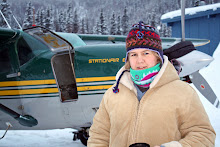Mekoryuk Trip Report
I spent last weekend on Nunivak Island in the village of Mekoryuk. As with my recent Hydaburg trip, this one was also through the Volunteer Tax & Loan Program (VTLP) which provides tax preparation services to the residents of Alaska Native villages throughout rural Alaska.
 I've been lucky enough to visit many little villages that I would otherwise not have had the opportunity to see.
I've been lucky enough to visit many little villages that I would otherwise not have had the opportunity to see. Mekoryuk is unique in many ways. The native language there is Cup'ig (pronounced choo-pik). They are the only population (about 200 people) who still speak this language regularly. The village of Mekoryuk was created by merging the dwindling populations of nearly 30 small Cup'ig villages which used to exist on the 1600-acre island. The site was chosen for its location near the coast and the mouth of a river.
Mekoryuk is unique in many ways. The native language there is Cup'ig (pronounced choo-pik). They are the only population (about 200 people) who still speak this language regularly. The village of Mekoryuk was created by merging the dwindling populations of nearly 30 small Cup'ig villages which used to exist on the 1600-acre island. The site was chosen for its location near the coast and the mouth of a river.Back in the 1930's a herd of musk ox were relocated to Nunivak Island in hopes of growing their numbers. I believe there are now around 500 musk ox on the island. It is possible to do a guided musk ox hunt on Nunivak. And while the meat is taken by the hunter, only the Alaska Native population is allowed to work with the musk ox "wool". It's called Qiviut and it is knitted and crocheted into lovely hats, scarfs, etc... They are very warm, and very pricy. The village contact for this trip was working on an earflap hat while I was there. She sells them for $250. If you bought it through the co-op in Anchorage, it'd be even more. Just about everyone in Mekoryuk had a Qiviut hat.
 Something I found unexpected about Mekoryuk, and Nunivak Island in general, was the flatness and whiteness of the terrain. Every other Alaskan island I've been to, Kodiak, Unalaska, and those in the southeast near Juneau, have been full of mountainous terrain. Nunivak, on the other hand, is almost completely flat. A treeless, white plateau 30 miles off the western coast of Alaska.
Something I found unexpected about Mekoryuk, and Nunivak Island in general, was the flatness and whiteness of the terrain. Every other Alaskan island I've been to, Kodiak, Unalaska, and those in the southeast near Juneau, have been full of mountainous terrain. Nunivak, on the other hand, is almost completely flat. A treeless, white plateau 30 miles off the western coast of Alaska. Because of this, it was very difficult to find something on which to focus your eyes. I found that the local people had comparatively poor eyesight. Undoubtedly caused by years of almost snow-blindness.
This problem came into sharp focus on the day of our departure. The airstrip, for some bizarre reason, lies 3 miles away from the actual village. We had the option of riding in a truck down a plowed "road" (think: tunnel of snow without a top) or on a snowmachine towing a sled. Silly us, we thought we were lucky to be taking the truck....
 |
| Road & airstrip from air. |
 |
| Plow exiting the "road". |
Combine white snow walls, a white snow trail, blowing white snow against a white sky with a driver who's been snowblind for decades, and you end up with an extremely motion sick me. We felt like a pinball traveling down a chute, bouncing from one wall to the other. We tried our best to direct the driver to stay to the trail. But, we could barely make out anything ourselves. The heat in the truck cab seemed to be stuck on swelter. And, as it was Sunday, the radio was blaring Cup'ig gospel music. Suffice to say, I was never so happy to fall out of a truck at an airstrip.

I took lots of photos which I will eventually load to an album. Once I do, I'll update this post with a link.


1 Comments:
Wow! That sounds like a crazy trip. I couldn't imagine looking at a featureless landscape for months at a time. It is great that they are keeping the Cup'ig language alive.
Rebecca
Post a Comment
<< Home